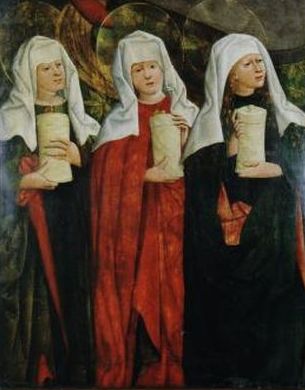The Myrrhbearers

The three saints who are commemorated on August 3rd, Joanna, Mary, and Salome “the myrrhbearers,” were the three women who brought spices to Jesus’ tomb so that they could anoint his body and give it a proper burial. Because the Sabbath had begun around the same time that Joseph and Nicodemus had brought Jesus’ body to Joseph’s tomb, no one had time to get Jesus’ body prepared for burial. All that Scripture tells us is that they laid a linen cloth on his body and rolled the stone in front of the tomb before they had to go home for the night (Luke 23:53).
Joanna, Mary, and Salome clearly wanted to finish the work that had been started that Friday evening, but they had to wait a whole day until the Sabbath was over to visit the tomb again. They got up early on Easter Sunday with the intention of putting perfumed ointments on the body of Christ.
When these three women arrived at the tomb early on Easter Sunday, they were met with quite the sight. Before they had even arrived, a great earthquake had shaken the tomb, and an angel of the Lord had rolled away the grave stone and sat on it, his face bright as lightning and his clothing as white as snow. The soldiers guarding the tomb were terrified of the angel and fell to the ground. Once they recovered, they fled the tomb, leaving it open.
Thus, when Joanna, Mary, and Salome arrived, they found an empty tomb. The women went inside and found two angels who announced to them that Jesus of Nazareth was no longer dead but had risen, as he had promised. Sometimes known as “the first evangelists,” the women were instructed to tell the disciples what they had seen and heard. Yet as they ran away from the tomb, Jesus intercepted them! He greeted them and told them, “Do not be afraid. Go and tell My disciples to go to Galilee. There they will see Me.” (Matthew 28:8-10).
A Brief History
So who exactly were these women who went to Jesus’ tomb that morning, and what was their connection to our Lord? As you might gather, this question can be easier to ask than to answer since identifying certain biblical figures can be difficult and sometimes even cause confusion regarding who is who (much like the example of St. Bartholomew and Nathaniel being the same person).
Here is what we do know. Joanna was the wife of Chuza, the head of Herod’s household (Luke 8:3). She is also mentioned in chapter 8 of Luke as a financial supporter of Jesus and his apostles. Perhaps this was because Jesus had healed her from some infirmity. Similarly, Scripture often pairs her with her more famous companion, Mary Magdalene, both because of their connection in the healing stories of Luke 8 and because the two went together on Easter morning to prepare Jesus for burial (Luke 24).
Mary was the mother of James the Younger, one of the twelve disciples (Mark 15:40). Both Mark 16:1 and Luke 24:10 relate that she went to Jesus’ tomb that morning. Matthew 27:56 also says that she watched the crucifixion from a distance and thus was present at many of the key moments surrounding Christ’s passion. Alongside Mary of Clopas (for whom she is often mistaken) and Mary Magdalene, this Mary is considered one of the Three Marys at the tomb.
Lastly, Salome was the mother of Zebedee’s sons, James the Elder and John, two of the other twelve disciples who were known as the “sons of thunder.” Mark 15:40-41 identifies Salome not only as present at the crucifixion and tomb but also as one of the women who followed Jesus and ministered to him when he was in Galilee. She is perhaps most recognizable from her appearance in Matthew 20:20, where she petitions Jesus to let her sons sit with him in Paradise.

The Church has long remembered these three women (along with Mary Magdalene, who is commemorated on her own day), as some of Jesus’ most loving and devoted followers. They were women who couldn’t wait to tend to their master and to care for his body, even in his suffering and death. Together, these women were the first to see our Lord resurrected!
Although their August 3rd feast date is unique to our LSB sanctoral calendar, these women have all been historically celebrated by the Church on their own individual dates throughout the year. Yet their collective experience and role in the resurrection make it fitting for them to share a celebratory day and for us to take the time in the middle of the summer feasts and festivals to reflect once again upon their role in the story of that blessed Easter morn!

Collect
Hear us, O God, our Savior: so that we, who rejoice in the feast of Blessed Joanna, Mary, and Salome, may learn from their spirit of loving devotion; through Jesus Christ, Thy Son, our Lord, who liveth and reigneth with Thee and the Holy Ghost: ever one God, world without end. Amen.
First Reading
Gospel
Resources
Propers found in Daily Divine Service Book: A Lutheran Daily Missal, edited by the Rev. Heath Curtis
Issues, Etc. interview with the Rev. Dr. Michael Eschelbach on Joanna, Mary and Salome
Issues, Etc. interview with the Rev. Dr. Arthur Just on the Myrrhbearers
References:
1. Weedon, William. Celebrating the Saints. Concordia Publishing House. 2016.
2. Concordia Publishing House. “Devotional Reading for the Commemoration of Joanna, Mary, and Salome. August 3rd, 2018. https://blog.cph.org/read/church-year/joanna-mary-salome-commemoration.
Images:
1. Joanna, Mary, and Salome, Unknown, Russia, ca. 6th century.
2. Three Marys at the Tomb, Nicolaus Haberschrack, Poland, c. 1570.
3. The three women on the tomb of Christ, Irma Martin, France, 1843.
Some links might be affiliate links which means we may receive a small commission at no extra cost to you. As an Amazon Associate we earn from qualifying purchases.




Excellent sermon on Mary magdalene! I enjoyed it very much with new insight.
Margaret Pariseau